October 19, 2018
Air Date: October 19, 2018
FULL SHOW
SEGMENTS
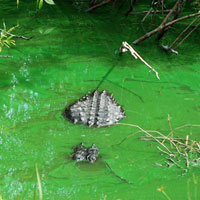
Red Tide Boosts Blue Wave
View the page for this story
In Florida a surge of toxic red and green algae blooms has fueled frustration with Republican Governor Rick Scott. Critics blame “Red Tide Rick,” who is running for a US Senate seat, for not doing enough to control this ecological crisis while he says his opponent, incumbent Democratic Senator Bill Nelson, is at fault. For a breakdown of how this ecological disaster is shaping Florida’s politics this November election, Host Steve Curwood spoke with Politico Reporter Michael Grunwald. (11:15)
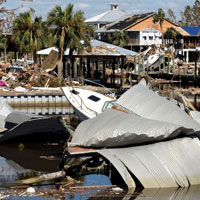
Beyond The Headlines
/ Peter DykstraView the page for this story
Peter Dykstra and Host Steve Curwood cover Florida and other states where the environment is front and center in the 2018 midterm elections, and the Prime Minister of Pakistan’s mission to plant 10 billion trees throughout his country. In this week’s look into the history vault, they discuss the Harding Administration scandal in the 1920’s known as “Teapot Dome.” (03:19)
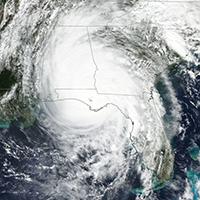
A Warmer World Supercharged Hurricane Michael
View the page for this story
Supercharged by a warmer world ,Hurricane Michael ripped through the Florida Panhandle with Category four winds and an 8-12 foot storm surge. Host Steve Curwood and Michael Mann, a climate expert at Penn State University, discuss how unusually warm waters in the Gulf of Mexico fed the hurricane’s rapid intensification and essentially doubled its destructiveness. Climate change is linked to warmer waters as well as worsened storm surge because of rising seas, and Prof. Mann says that the window to reduce climate-changing gas emissions to safer levels is swiftly closing. (09:30)
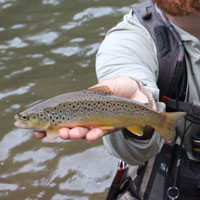
Fly-fishing Saved From Pollution
/ Julie GrantView the page for this story
The trout in Central Pennsylvania’s waterways face pollution from agriculture and development. But as Allegheny Front Reporter Julie Grant explains, this area still has some great fly-fishing, and passionate, local conservationists are working to keep it that way. (04:39)
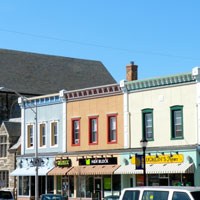
Barbara Kingsolver, Unsheltered
View the page for this story
Writer Barbara Kingsolver has just released her ninth novel, titled Unsheltered. The novel tells the story of one family’s crisis in modern America, and the tribulations of another family that lived in the same house in South New Jersey more than a century ago. The social and environmental issues presented in Unsheltered include economic crises and the denial of science, and resonate with America’s past and present realities. Barbara Kingsolver joins Host Steve Curwood for a discussion about her latest novel, which was six years in the making. (13:36)

Vegan Generation Gap
/ Paloma BeltranView the page for this story
Traditional family recipes can go back through the generations, and that can present challenges when members of the newest generation go vegan. Ratatouille can be one answer, as writer and UMass Boston student Paloma Beltran tells us. (03:00)
Show Credits and Funders
Show Transcript
HOST: Steve Curwood
GUESTS: Michael Grunwald, Barbara Kingsolver, Michael Mann
REPORTERS: Julie Grant, Paloma Beltran, Peter Dykstra
[THEME]
CURWOOD: From Public Radio International – this is Living on Earth.
[THEME]
CURWOOD: I'm Steve Curwood. Slimy green algae and the red tide in Florida may tip the scales in the upcoming midterm elections for the Senate.
GRUNWALD: This is a rough time for Governor Scott or as he's now becoming known on social media – they're calling him Red Tide Rick. Generally when you're a politician you don't what to be a meme, and you definitely don't want that meme to involve scum.
CURWOOD: Also, acclaimed novelist Barbara Kingsolver has a new book out looking at the social and environmental issues of our day and a century past, it’s called Unsheltered.
KINGSOLVER: I think we're in the moment when so many things that we've always believed in are suddenly starting to feel not true anymore. It's a moment that feels like crisis.
CURWOOD: Those stories and more this week on Living on Earth – Stick Around!
[NEWSBREAK MUSIC: Boards Of Canada “Zoetrope” from “In A Beautiful Place Out In The Country” (Warp Records 2000)]
[THEME]
Red Tide Boosts Blue Wave
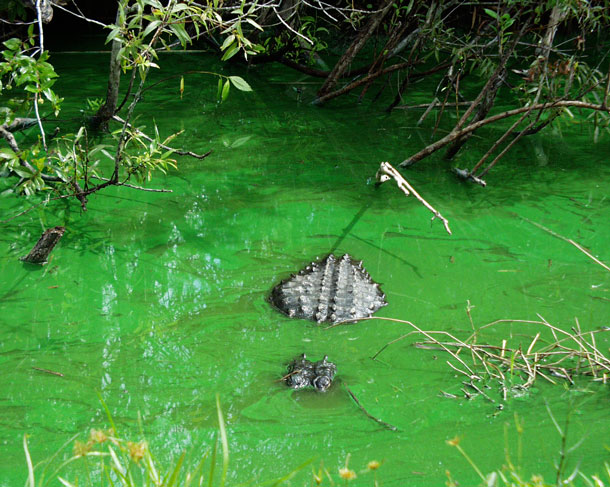
An alligator peeks above the so-called “green glop,” a.k.a an algae bloom that has overtaken many of Florida’s waterways and beaches. (Photo: Caleb Slemmons, Flickr CC BY-NC 2.0)
CURWOOD: From PRI and the Jennifer and Ted Stanley Studios at the University of Massachusetts Boston this is Living on Earth. I’m Steve Curwood.
In Florida, large swaths of toxic green algae blooms and so-called “red tide” blooms have infested shore lines, killing marine life, harming humans, and stifling the tourism industry. And there’s a fourth way it could alter the future of the sunshine state, and that’s in the 2018 midterm elections. Republican governor and US senatorial candidate Rick Scott has been praised for his handling of the hurricane emergencies, but he’s being blamed by protestors for the massive algae problem. Rick Scott holds a narrow lead in most polls over his Democratic opponent, incumbent Senator Bill Nelson, but anti -algae activists could influence turnout. For a look at how the algal blooms might influence Florida politics in November, we turn to Politico Senior Reporter Michael Grunwald. Welcome to Living on Earth!
GRUNWALD: Thanks for having me.
CURWOOD: So, briefly for our listeners who just may not be up to speed on this issue. What are these red and green toxic algae blooms, and why are they impacting Florida's coastline in the first place?
GRUNWALD: Well, as you mentioned, we have two different types of algae blooms. One is this kind of neon green guacamole glop that is toxic and has been linked to cancer and various testicular problems, and then you have these sort of rust colored red tides, and that's where you've probably seen on TV the millions of fish rolling up dead on the white sand beaches of the west coast. And essentially you're talking about microorganisms that, as Rick Scott's administration is always pointing out, they are naturally occurring but they feed on nutrients, the crud that human beings put into the water, and that's what really super charges them and makes them bloom. And right now we've got a real nutrient problem and that's why you see it really taking off and destroying the tourist economy on both coasts.
CURWOOD: How important is the health and safety of Florida's waterways to its citizens?
GRUNWALD: Well, you know it's generally bad when the water that's all around us is kind of destroying our health. And remember, I mean, most of us came down here because it's nice. Florida's environment really is its economy, and it's the reason you have 20 million people living here and 100 million annual tourists visiting here is because it's a really beautiful place. And when you can't breathe at the beach, when you can't go into the water, when the sparkling estuaries that are considered the most biodiverse in North America are covered with this blanket of foul-smelling, green scum, that's not really popular.
#RedTideRick's disastrous environmental record sure is colorful. (Cartoon by @wuerker) #NotScott #FLSen pic.twitter.com/6KiAbDAme6
— Rick Scott Is Not For Florida (@NotForFlorida) September 20, 2018
CURWOOD: No, I don't think so. So, Governor Rick Scott is the Republican Senate candidate this year. Why is he bearing the brunt of the blame over these red tide blooms?
GRUNWALD: Yeah, this is a rough time for Governor Scott, or as he's now becoming known on social media they're calling him "Red Tide Rick". I mean, look I think it's partly because he's sitting in the chair, right? He's been governor for eight years and suddenly there's an ecological meltdown happening on his watch. He's also he's a Tea Party Republican, and he's described himself as the jobs-jobs-jobs governor, and part of his push for promoting Florida's economy has been dismantling some of its environmental regulations, and particularly regulations that have to do with nutrients. He actually signed a law repealing inspections of septic tanks that have been sending some of these nutrients into the waters. And he actually specifically asked the federal government for relief from nutrient standards. And he has really gutted some of the environmental agencies that we're doing enforcement and regulation of the nutrients that are in the water. So, there is a pretty plausible case that keeping nutrients out of the water has not been his top priority and that pollution right how is creating these really serious, not just environmental but economic, problems.
CURWOOD: And when you say nutrients we're really talking about things like poop, fertilizer, excesses and such like that.
GRUNWALD: Yeah, exactly we're talking about nitrogen and phosphorus. Nutrients sound great because they make things grow, right? They're nutritious. Unfortunately, they also happen to be nutritious for algae, and that's why you're seeing these super charged blooms on both coasts.
CURWOOD: You know, we talk a lot about slime in politics, but this is one of the first times that I've ever talked about it literally.
GRUNWALD: I would say, like you generally when you're a politician you don't want to be a meme, and you definitely don't want that meme to involve scum.
CURWOOD: [LAUGHS] So, to what extent are the candidates here for Senate addressing, or maybe they're not addressing, the issue of these blooms?
GRUNWALD: Well, it's been a huge issue for Senator Nelson, who of course, is saying that this is Rick Scott's pollution, that he is directly responsible. And Governor Scott has already put $20 million dollars of his own money into campaign advertisements and he's taking this head on and making this kind of circuitous this argument that actually this is Senator Nelson's fault. And his argument has to do with Lake Okeechobee and in the middle of the peninsula which is known as the kind of liquid heart of Florida, and 90 percent of it this year was covered in toxic algae...when the lake gets too high the Army Corps of Engineers has to blast that filthy water east and west into the estuaries that have had some really serious toxic algae blooms.
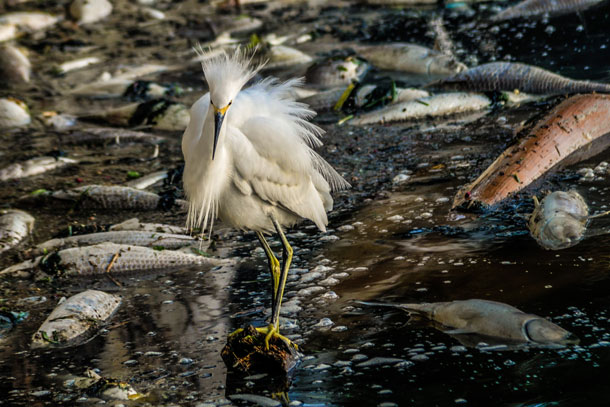
Thousands of fish have been killed by red tide on Florida’s gulf coast. (Photo: Susan Frazier, Flickr CC BY-NC 2.0)
And Governor Scott has argued that because the Congress has not provided enough money for fixing that dike, they have had to let the water out at an earlier time than they would have had to otherwise, and that therefore that's why it's happening and then Senator Nelson who has been in the Congress for too long hasn't done enough to get money to fix the dike. Well, of course, most people are sort of saying, like, well yeah, but the water is dirty...it's not supposed to be dirty and the state is in charge of water quality in Florida and every state.
CURWOOD: So, how much is this hurting the campaign of Rick Scott?
GRUNWALD: Well, it's definitely not helping. One of the problems he's facing is that the brunt of the toxic algal blooms are largely being felt in really staunchly Republican coastal areas. We're talking about actually around his own hometown of Naples. He actually had to cancel an event that he was supposed to do there because there were going to be so many protesters. He got chased out of a restaurant in Venice, another staunchly Republican area on the west coast. And over in Stuart on the east coast where President Trump got 66 percent of the vote, he hasn't been able to get out of his car because there's been so many protesters yelling at him about the glop in the water. So, this is a real problem for him. That's one of the reasons he's fighting back so hard with his campaign ads.
CURWOOD: So, now these protesters. Are they trolls that have been hired by the opposition, or are these folks in neighborhoods that are really upset?
GRUNWALD: No, people are really mad and you can see there's all kinds of evidence. Look, people don't like slime in their backyard. Now, do Republicans end up coming out and voting for Scott anyway just because he's a Republican or because they like what he says about taxes or because they don't like Chuck Schumer? That's certainly possible, but every election and every statewide election in Florida is close. Governor Scott won both of his races by one point. So, this is something where if the slime, if it flips a few voters or if it persuades a few voters to leave the Rick Scott space blank, that could really spell the difference between losing and winning.
CURWOOD: So, how have environmental issues featured in past elections in Florida?
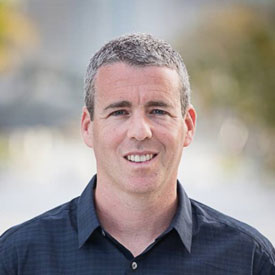
Michael Grunwald is a Senior Reporter at Politico. (Photo: Courtesy of Politico)
GRUNWALD: You know, Florida is...in the last 20 years, Republicans have won the governor's race, have dominated the legislature. It's obviously a swing state, but has definitely tilted red but it has always tilted green. The story I like to tell is that Jeb Bush in 1994, when people were talking about him that he was sort of the heir apparent to his dad who was most likely going to be president some day, that was 1994, a huge Republican year, and Jeb ran as a right wing conservative. He was actually making fun of environmentalists on the campaign trail, and he turned out to be one of the only Republicans to lose that year, and his brother became the kind of heir apparent. Four years later, one of the first things he did after he lost the election was he joined the Audubon Society, and Jeb ran in 1998 as a green Republican and he won in a landslide. So, this is something where it's not always the deciding issue, but it's an issue where you don't want to be on the wrong side of, and so far in Florida that really has been lacking, and that's become a really big issue in the governor's race where you see a Democrat, Andrew Gillum, who is talking about making it a top priority and in the Senate race where Democratic incumbent Bill Nelson, who is not anybody's idea of a particularly inspiring or effective leader mobilizing action on climate change, but has been at least on the side of doing something, and Rick Scott hasn't and he's trying to make that an issue.
CURWOOD: By the way, what about climate change? As governor, Rick Scott is famous for telling agencies not to use that phrase. And yet, you guys have been horribly slashed by Hurricane Michael. Irma, down south in Florida pretty tough time last year. How does climate figure into this?
GRUNWALD: I lived until a couple years ago in South Beach and we'd have sunny days where Biscayne Bay was rising through our storm drains at high tide. Climate change is with the possible exception of Alaska, it's as tangible in Florida as it is anywhere else. Most of our state is very close to the coast. We are a peninsula jutting into the Gulf Stream, we're right in Hurricane Alley. These are all incredibly powerful motivators for Floridians to at least pay attention to climate change and that is an issue where Rick Scott has been on the other side.
CURWOOD: Um, Michael, looking ahead, what hope do you see the Florida will remain a livable and economically viable place in these coming decades given all these issues?
GRUNWALD: Well look, I'm a sort of short term pessimist and a long term optimist. I voted with my feet. I moved here. I'm raising two kids here. We're just going to have to figure out how to live more sustainably and we're going to have to take better care of the waterways that make this such an awesome place. We are just going to have to stop dumping our crap and it and what people like me have always said is that eventually Mother Nature is going to scream loud enough that we're going to have to listen, and certainly right now we're hearing that scream and we'll see if the politicians listen.
CURWOOD: Michael Grunwald's book is called "The Swamp: The Everglades, Florida and the Politics of Paradise." He's a senior reporter with Politico. Michael, thanks so much for taking the time with us today.
GRUNWALD: Thanks for having me.
CURWOOD: For the record Governor Scott did declare a state of emergency for red tide and said, “As Southwest Florida and the Tampa Bay area continues to feel the devastating impacts of red tide, we will continue taking an aggressive approach by using all available resources to help our local communities.”
Related links:
- Politico | “How Red and Green Slime (Really) Could Swing Florida’s Senate Race”
- Governor Scott Declares Red Tide Emergency
- Senate Campaign website for Rick Scott
- Senate Campaign website for Bill Nelson
- Michael Grunwald Politico Profile
[MUSIC: Libana, “Kwaheri” on Fire Within, traditional Kenyan, Ladyslipper Music/CD Baby]
Beyond The Headlines
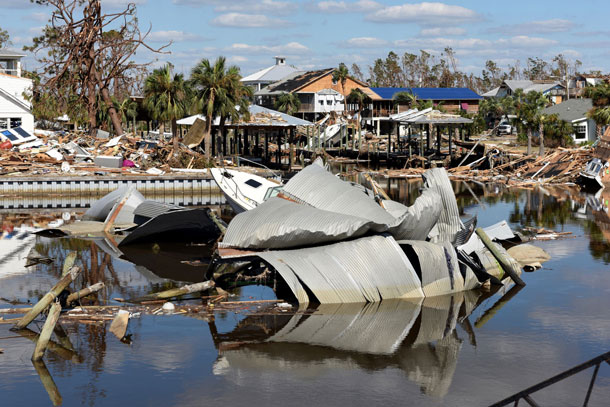
The destruction caused by Hurricane Michael is just one of many environmental issues at the center of Florida’s midterm election. (Photo: Coast Guard News, United States Coast Guard, Flickr, CC BY-NC-ND 2.0)
CURWOOD: Lets take a look behind the headlines now, with Peter Dykstra, he’s an editor with Environmental Health News, that’s EHN.org, and DailyClimate.org. On the line now, from Atlanta, Georgia, in the middle of this political season Peter, hey what’s going on?
DYKSTRA: Hey, Steve. We heard earlier in the show from Michael Grunwald about the race in Florida, the algae blooms on both coasts and everything, but let’s consider and appreciate that it’s a real breakthrough in Florida, in the Senate race, because I can’t think of any time when environment has been as front and center in a tight political race as it is now between Governor Rick Scott, challenging Bill Nelson for his senate seat.
CURWOOD: I have to agree with you, I’m trying to think of when it was at the top of the ballot, and I’m not sure we’ve seen it this way in a major race.
DYKSTRA: No. It’s because there’s a lot going on with the environment in Florida.
CURWOOD: Hey, talk to me about where else in the country we’re seeing the environment. I think it’s mostly in ballot issues, right?
DYKSTRA: That’s right. There’s a big initiative in Washington State dealing with climate change that also hopes to put a carbon tax within the state. It’s opposed by a lot of fossil fuel entities; the Western States Petroleum Association is the biggest one. In Alaska and Montana, there are clean water initiatives on the ballot, and clean energy initiatives in the states of Arizona and Nevada.

When Imran Khan was a provincial official in Pakistan, his administration planted hundreds of thousands of trees. Now that he’s Prime Minister, he intends to plant 10 billion. (Photo: Jawad Zakariya, Wikimedia Commons, CC BY-SA 3.0)
CURWOOD: Hmm, and Arizona and Nevada also have some pretty close Senate races. What else do you have for us today?
DYKSTRA: Well, Imran Khan was a provincial politician in Pakistan. His province had seen huge environmental degradation from deforestation, from timber theft. And as a provincial official, he proposed the planting of one billion trees in his province.
CURWOOD: Well, that’s a big deal. How well did it work?
DYKSTRA: They didn’t get anywhere near a billion, but they still managed to plant a few hundred thousand trees, and it made a difference. And now Imran Khan is no longer provincial official, he’s the Prime Minister of Pakistan, the fifth most populous country in the world, with 212 million people, and growing fast. As it grows, the land use issues, the deforestation issues become more critical, and he’s now proposed planting 10 billion trees.
CURWOOD: Hey, what do you have from the history vaults for us this week?
DYKSTRA: Let’s go back to 1929, another instance of “draining the swamp” from the White House. The Warren G. Harding administration, short-lived because Harding died in office, but they managed to put together a bodacious reputation for corruption. Albert Fall was the Interior Secretary. And, long after Harding died and the administration faded away, in 1929, in October, Albert Fall was convicted of bribery in an oil scandal that became known as Teapot Dome.
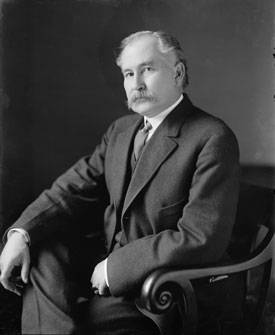
Albert Fall, Secretary of the Interior during the Warren G. Harding administration. (Photo: Harris & Ewing - Library of Congress Prints and Photographs Division, Wikimedia Commons, Public Domain)
CURWOOD: Hmm, and I gather he went to jail?
DYKSTRA: A year in prison, plus a hundred thousand dollar fine, that was a lot of money back in those days. And the hundred thousand dollars, ironically, exactly matched the amount of the bribe he took.
CURWOOD: Peter Dykstra is with Environmental Health News, that’s EHN.org, and DailyClimate.org. We will talk to you again real soon, Peter.
DYKSTRA: Looking forward to it, Steve, thanks a lot.
CURWOOD: And there’s more on these stories at our website, LOE.org.
Related links:
- Environmental Health News | “What Will It Take On Climate Change?”
- The Revelator | “The Environment Is on the November Ballot — Here’s Where and What’s at Stake”
- Washington Post | “In Pakistan, an Ambitious Effort to Plant 10 Billion Trees Takes Root”
- History.com | “Cabinet Member Guilty in Teapot Dome Scandal"
[MUSIC: The Blue Dahlia, “Wake Me Up” on La Tradition Americaine, self-published]
CURWOOD: Coming up, good news for one of the best fly-fishing destinations in the US. That’s just ahead on Living on Earth.
ANNOUNCER: Support for Living on Earth comes from the Gordon and Betty Moore Foundation and from a friend of Sailors for the Sea, working with boaters to restore ocean health.
[CUTAWAY MUSIC: The Blue Dahlia, “Influence III” on La Tradition Americaine, self-published]
A Warmer World Supercharged Hurricane Michael
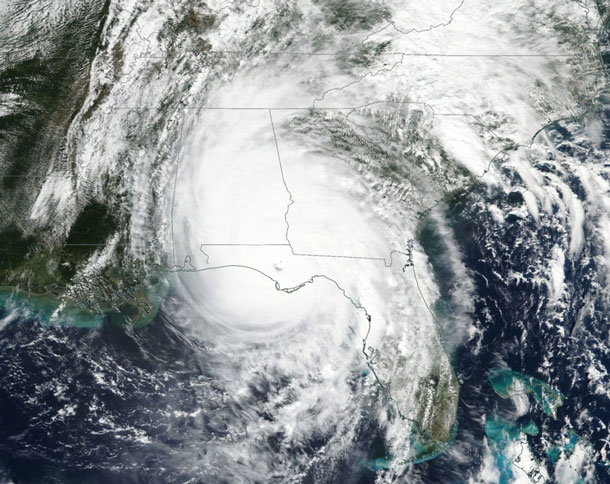
Hurricane Michael after it made landfall in the Florida panhandle on October 10th. (Photo: NASA Worldview/ NOAA)
CURWOOD: It’s Living on Earth. I’m Steve Curwood.
When Hurricane Michael came ashore in the Panhandle of Florida on October 10th it shredded buildings with the sheer force of its Category-4 winds, and swept away entire neighborhoods with an 8-12 foot storm surge. Michael is the third strongest hurricane ever to make landfall in the continental United States. It passed through quickly though and dropped less rain than other recent major hurricanes such as Florence, Harvey, Irma and Maria. Only the Labor Day hurricane of 1935 and Hurricane Camille in 1969 had lower barometric pressures, a key measure of hurricane strength. And even some storm experts were surprised by how Hurricane Michael intensified from a Category 1 to Category 4 in just 24 hours. Here to talk about this unprecedented storm and its possible climate connections, we welcome another Michael back to the show. Michael Mann is a climate expert at Penn State University. Welcome back to Living on Earth!
MANN: Thanks, Steve. It's good to be with you.
CURWOOD: So, why did Hurricane Michael intensify so quickly?
MANN: So, it encountered warm sea surface temperatures in the low 80s in the region where it intensified and became a major hurricane. Those temperatures are between two to three degrees Celsius above pre-industrial temperatures.
CURWOOD: Why is that? Why was the water so warm there? Just a fluke or are we looking at a trend?
MANN: So, there's been a degree Celsius of warming. Globally, the oceans have warmed up, and it's an ocean heat wave. An ocean heat wave just like a normal heat wave is made much more likely with even a modest warming of the planet.
CURWOOD: Now, Hurricane Michael brought some pretty intense storm surges, eight to 12 feet in some of the coastal areas there. How much the sea level rise factor into a storm surge these days?
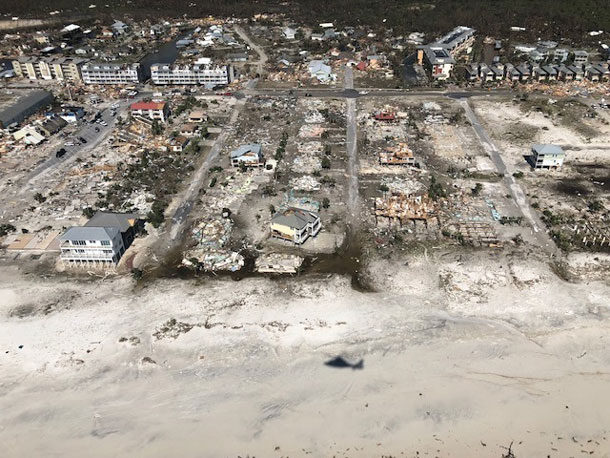
Devastation at Mexico Beach, seen from a Coast Guard MH-65 Dolphin aircrew on October 11, 2018. (Photo: U.S. Coast Guard photo by Petty Officer 1st Class Colin Hunt, Flickr CC BY-NC-ND 2.0)
MANN: Well, you know sea level rise depending on where you are in the Gulf Coast or the US east coast has been somewhere between half a foot and a foot, and that's the warming of the planet, the melting of the ice. That's us. Sea level rise adds to the storm surge of every single storm that makes landfall. In the case of Sandy, Superstorm Sandy, in 2012, it added a foot to that 13 foot storm surge. It might sound like a modest amount. One foot. Well, it meant 25 more square miles of coastal flooding. It meant several billion dollars worth of additional damage. Same thing with Florence making landfall in North Carolina. Again about a foot of sea level rise added to that storm surge.
CURWOOD: How much more frequent will these storms be? Particularly the Hurricane Michael type? This sort of intense quick pop up.
MANN: One of the things that we're seeing with warmer and warmer ocean temperatures, you're more likely to see what we call rapid intensification, and we have seen this now so many times where a storm balloons from a minor tropical storm to a major hurricane over the course of a day or two and that only happens over very warm seas. And are we getting more of these very intense storms, these category three, four, five storms? And that's where the science is actually the strongest. In fact, there's a relationship for a category five storm. You get an increase of roughly seven percent in the maximum wind speeds for each degree Fahrenheit warming of the ocean. Now, that seven percent increase in wind speed might sound modest, but the destructive potential of a storm goes as the third power of the wind speed. So, a seven percent increase in wind speed is a 21 percent increase in the destructive potential of the storm. That's for one degree Fahrenheit. Well, with Michael those temperatures were two to three degrees Celsius above pre-industrial temperatures. If you do the math, that means it was probably twice as destructive as it would have been in the absence of human caused warming.
CURWOOD: The latest in the International Governmental Panel on Climate Change report is saying that the world faces perhaps more severe climate impacts if global average surface temperatures rise more than the one and a half degrees Celsius, above the pre-industrial temperatures. What do we know now about how hurricanes could behave with the world that's more than one and a half degrees warmer than before the Industrial Age?
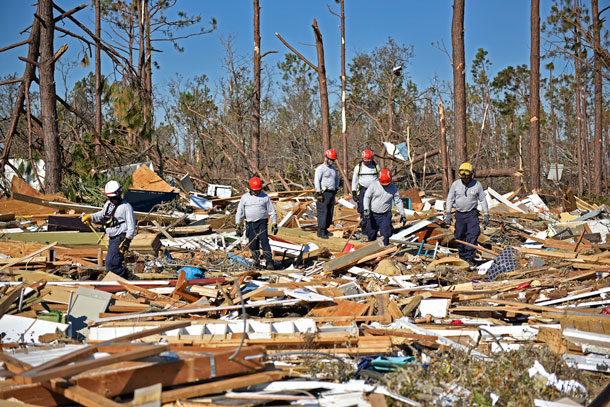
A massive search-and-rescue effort following Hurricane Michael. (Photo: Andy Wraithmell/Florida Fish and Wildlife, Flickr CC BY-NC-ND 2.0)
MANN: Yes, so for each half degree Celsius - that's the better part of one degree Fahrenheit - right there that's a 21 percent increase in the destructive potential of the storm. That means noticeably more damage, it also means for each half a degree Celsius, you have about four percent more moisture in the atmosphere, so you're going to increase the potential for those flooding rains and, of course, it's impacting lots of other weather extremes and global sea level rise and all of these other attributes of climate that we are sensitive to.
CURWOOD: In the past the IPCC has been a bit conservative. When the data comes in, their projections have been lower than the actual numbers. How do you think this report will fare when the actual data comes in?
MANN: Yes, so I've criticized this latest report for once again being overly conservative in its portrayal of the science, and I'll tell you it has to do with a very specific criticism in this case. It's the way that they measure the warming that has happened and the IPCC has chosen to measure the overall warming that's taken place using a baseline that starts in the late 1800s, and the reason for that is, well, that's how far back the thermometer measurements go. Here's the problem. Human-caused warming began back in the 1700s when industrialization began, so every tenth of a degree Celsius of warming that's happened makes it that much more difficult to stabilize below 1.5. Maybe it's impossible now, 1.5...2.0 there's still a clearer path towards stabilizing warming below two degrees Celsius, but it turns out that if you look at our budget, how much carbon do we have left that we can burn and avoid two degrees Celsius? If you take in what might sound like a small factor, the use of an earlier more appropriate baseline for measuring the warming relative to the pre-industrial, you have about half as much carbon that you can burn. So, it was for that specific reason that I criticized this report as being overly conservative. Again, it made some choices that in my view understate the amount of warming that's already happened and thus overstates the amount of carbon we still have left to burn.
CURWOOD: So, let's talk about that carbon budget. How many gigatons of carbon does modern society toss into the atmosphere on an annual basis and how much more room is there?
MANN: Yes, so we are burning right now about still about 30 gigatons, 30 billion tons of carbon dioxide every year, and we probably only have about 150 gigatons CO2 left in that budget. It's all a question now about how quickly do we bring those emissions down. Here's the good news, they sort of flattened a few years ago, but flat lining isn't enough. We've now got to come down off the other side of the mountain. We've got to come down dramatically bring that emissions curve down dramatically if we are going to avoid committing to two degree Celsius warming. If we keep emissions flat at their current level, there is no way we get there.
CURWOOD: Wait, Professor Mann, that means we've got five years to get this right?
MANN: Yes, if we continue with the current rate for five more years. And here's another controversial choice by the IPCC. There are scenarios, the scenarios that they put out, for stabilizing warming below one and a half or two degree Celsius, invoke what's known as negative carbon emissions. It means we're over our budget so we now have to take carbon back out of the atmosphere. Those scenarios allow us to continue to burn carbon now under the assumption that decades from now we will be able to remove it from the atmosphere. It's a faith in unproven technology that I'd consider foolhardy.
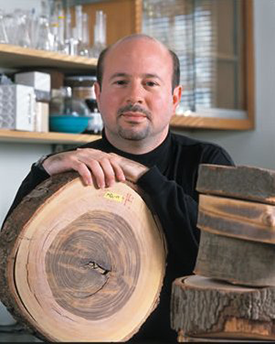
Michael Mann is Distinguished Professor of Atmospheric Science at Penn State University. (Photo: Penn State University)
CURWOOD: Professor Mann, how scared are you?
MANN: I'm certainly frightened of the possibility that we will not act in time. I hold out cautious optimism for the scenario that we do, and let me be specific. Do I hold out much optimism for stabilizing warming below one and a half degrees Celsius? No, I don't at this point? Do I still see two degrees Celsius, stabilizing warming below two degrees Celsius, as possible? I do, but we need to again dramatically reduce our carbon emissions, not 10 years from now. Now. But it isn't a cliff that we go off of at 1.5 or two degrees Celsius. It's much more like a minefield that we walk out onto and the further out onto that minefield, the more likely it is that we set off these devastating detonations. And that is why we have to limit the warming as much as we possibly can.
CURWOOD: Michael Mann is a Distinguished Professor of Atmospheric Science and Director of the Earth System Science Center at Pennsylvania State University. Thanks so much, Professor Mann, for taking the time today.
MANN: Thank you. It was my pleasure, Steve.
Related links:
- Columbia Journalism Review | “Yes, Hurricane Michael is a climate change story”
- The Atlantic: | “The Sudden, Shocking Growth of Hurricane Michael”
- About Professor Michael Mann
[MUSIC: David Munnelly, “Ar Bhóitrin Na Smaointe” on By Heck, by D.Munnelly/arr.D.Munnelly & R.Mollag, Mad River Records]
Fly-fishing Saved From Pollution
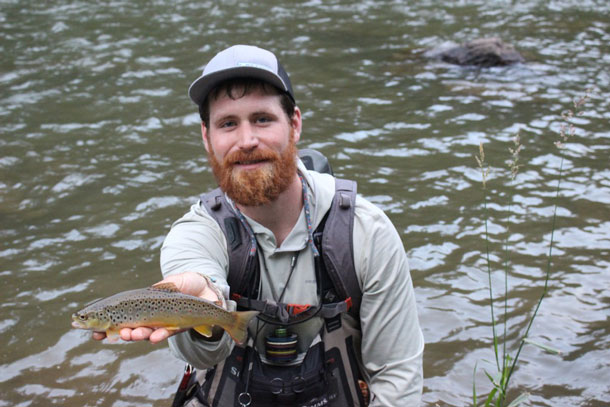
Matt Kowalchuk, a fly-fishing guide in central Pennsylvania, displays a brown trout he caught at Penns Creek. (Photo: Julie Grant)
CURWOOD: The wilder parts of the American West are famous for fly-fishing, but there are a lot of spots to catch wild trout in the Eastern U.S. including central Pennsylvania.
And that’s despite pollution from agriculture and development. Julie Grant of the Allegheny Front went to meet some of the people who are working to keep those premier streams clean.
GRANT: It’s just before sunset, and 27-year-old Matt Kowalchuk is standing in the river, near the bank of Penns Creek in central Pennsylvania, not far from State College. He’s a fly-fishing guide, and chooses a lure meant to catch wild trout.
KOWALCHUK: We’re going to see if we can get one to eat a stonefly, It’s hard to pass up a big meal.
GRANT: Kowalchuk attaches the fly to his line, and walks deeper into the center of the fast-moving creek. He casts upstream. His line doesn’t dance through the air like in A River Runs Through It, but the lure lands lightly on the water, and floats down a ways. He doesn’t get any bites, so he pulls the lure out, and casts upstream, again.
KOWALCHUK: And you do it again, and you do it again, and you do it again, and you do it again, the next thing you know, a bar of gold just rolls up and annihilates your fly. That’s pretty intense. It gets the adrenaline pumping.
GRANT: Kowalchuk considered moving to Montana or Colorado after college, but he loves it here
KOWALCHUK: In the middle of Pennsylvania, mountains all around you, watching the bald eagles chase the osprey for the trout.
GRANT: In high summer, the water is still cool at about 60 degrees. It stays that temperature because it’s fed by cold springs and mountain creeks. Unlike some streams, the state doesn’t stock Penns Creek with trout.
KOWALCHUK: It doesn’t need it, this stream is Class A wild trout water, meaning that it has a naturally sustaining population of fish that does not need us to do anything about. If you come here in October and November, you can walk the stream and find the fish actively spawning, and that is cool to see.
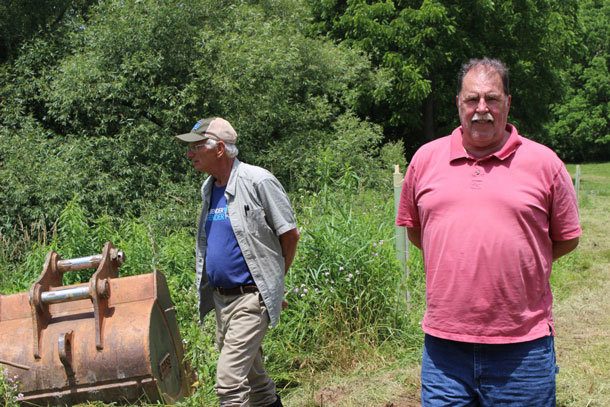
Penns Valley Conservation Association member Lysle Sherwin (left) is looking for ways to stop erosion from contaminating the stream with David Martinec (right). (Photo: Julie Grant)
GRANT: One reason the trout do well here is the abundance of food. When I visited, Kowalchuk was just finishing up with the angling frenzy around the hatch of green drake, an especially large mayfly.
KOWALCHUK: That’s the reason that everyone comes to fish, the green drake, It’s actually pretty insane.
GRANT: Even closer to State College, in nearby Spring Creek, a spill of cyanide at Penn State in the 1950s wiped out the green drake population. The mayflies have never recovered there. There’s usually not one big pollution source anymore, today, it’s more like death by a thousand cuts. Urbanization and growth in State College, like rooftops, roads and parking lots, cause runoff and pollution in Spring Creek. In the more rural Penns Creek watershed, it’s the farms. One-third of the land here is used for agriculture corn, soy and dairy.
MARTINEC: This is a cow pasture, and that was a cow pasture. David Martinec is working with PVCA, a local non-profit, to restore the streambed at his long time family farm. He points to the high bank on the far side of the creek, where a backhoe is moving hemlock logs brought in for a restoration project.
MARTINEC: When we took the cattle off, the non-native invasive species just grew up , and choked everything out.
The PVCA’s Lysle Sherwin who leads many area landowners on projects like this, says the bare soil of the cow pastures left these stream banks without tree roots for structure.
SHERWIN: They’re falling into the stream, massive erosion.
GRANT: You can see silt from the eroding bank filling up the shallow stream here. Sherwin says this limestone bed is the spawning ground for trout, and the sediment literally smothers their eggs.
That’s why they’re building what’s basically a reinforced wall of logs along the stream.
SHERWIN: It simulates an eroded bank that has structure and function to it, but it’s a built bank, it’s a stable bank.
GRANT: Sherwin has worked on 14 improvement projects like this in recent years, and says the more they do, the more landowners want to try it.
SHERWIN: It’s sort of keeping up with the Joneses. ‘Oh wait a minute, they did that stream project, and it worked for them. And they seem happy with it.’
GRANT: Many of these projects get funding through a United States Department of Agriculture program that’s proposed to be cut in the House version of the 2018 Farm Bill.
Sherwin hopes funding doesn’t dry up, because the more stream restoration the better for the wild brown trout in Penns Creek and for the anglers who pour in to catch them.
I’m Julie Grant.
CURWOOD: Julie Grant’s story comes to us courtesy of the Allegheny Front.
Related links:
- Cabela’s guide to great fly fishing in the Eastern US, including Penns Creek
- Listen on the Allegheny Front Website
[MUSIC: Jeff Little, “’A’ Strange Thing” on Piano Man from the Blue Ridge, self-published.]
CURWOOD: Coming up – Acclaimed novelist Barbara Kingsolver has new book, Unsheltered with insights on our changing world. Stay tuned to Living on Earth!
ANNOUNCER: Funding for Living on Earth comes from you our listeners and United Technologies, combining passion for science with engineering to create solutions designed for sustainability in aerospace, building industries, and food refrigeration. UTC companies such as Otis, Carrier, Pratt and Whitney, and UTC Aerospace systems are helping to move the world forward. You can learn more about United Technologies by tuning into the Race to Nine Billion podcast; listen at race to nine billion dot com. That’s race to nine billion dot com. This is PRI, Public Radio International.
[CUTAWAY MUSIC: The Punch Brothers, “Brandenburg Concerto No. 3, Allegro” on Live From the Lower East Side: It’s p-BingoNight!]
Barbara Kingsolver, Unsheltered
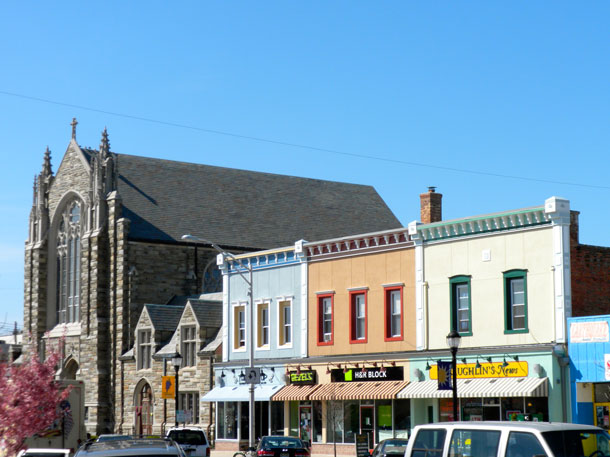
A downtown view of Vineland, New Jersey, taken from Landis Ave. (Photo: Wikimedia Commons, Public Domain)
CURWOOD: It’s Living on Earth. I’m Steve Curwood.
The more things change the more they stay the same, goes the French aphorism, and popular author Barbara Kingsolver has a brilliant take on these unsettling times in her new novel Unsheltered. It’s a creative look at a family’s crisis in modern America, layered over the narrative of a story that unfolded in the same New Jersey town over a century earlier. Vineland, New Jersey, was first settled in the late 1800’s as a utopian experiment and the social issues there, as imagined in Barbara Kingsolver’s book, Unsheltered resonate equally with America’s reality back then and today. She joins us now, welcome back to Living on Earth!
KINGSOLVER: Hi, thanks for having me.
CURWOOD: Barbara Kingsolver, this is your first novel in, what, six years? So, what brought you the idea of writing what became Unsheltered now?
KINGSOLVER: Well, it's one of those books that took a while to cook. I spent several years thinking about how to write about paradigm shift. That's what I think we're doing right now. I think we're in the moment when so many things that we've always believed in as truths unquestionable are suddenly starting to feel not true anymore. It's a moment that feels like crisis, like the end of the world as we know it. And when I say permanent truths, things like, well, like there will always be a job at the end of the college degree or tenure at the end of the track or a pension at the end of a career or good health care or even things like ice on the poles that will stay frozen, or that there will always be more fish in the sea. We're reaching a moment in history when all those shelters are failing us.
CURWOOD: So, your device, if I can use that word...
KINGSOLVER: Of course.
CURWOOD: ...is to have two families living more than a century apart in the same house.
KINGSOLVER: Right, and of course, it's falling down.
CURWOOD: Literally.
KINGSOLVER: It's literally falling down.
CURWOOD: And that's another thing that is in question these days. Where is it safe to live? You know the occasional hurricane or maybe there's going to be a huge forest fire or whatever. In fact, you yourself you moved from the southwest back to Virginia because you could see that there ain’t going to be too much water there in Arizona.

Modern day issues mix with tales of the past and present in Barbara Kingsolver’s Unsheltered. (Photo: HarperCollins Publishers)
KINGSOLVER: Exactly. It was already functioning kind of like a spaceship. That everything people used there needed to be brought in from the outside. And in fact, we are kind of living on a spaceship. And we've been living on it for so long, I mean, well, not in terms of human evolution but in terms of present civilization. We've been operating on the presumption that our culture and our economy can grow infinitely. Just the presumption of infinite growth has to end somewhere. And we just keep throwing more of the same old request at the world of give me more. Let's grow more. Growth and consumption are seen to be the answer to our prayers. So, what happens when it seems like you're praying the wrong prayer?
CURWOOD: So, if I were to go through the various issues that are confronting people today, aside from the fact that it does seem like things are kind of falling apart, just sort of randomly you address parenting, romance among grownups, women in science, evolution, climate, feral cats, botany, fresh local food, suicide, tenure...oh, and did I leave out Trump?
KINGSOLVER: [LAUGHS] He's not mentioned by name. Any resemblance to people living are dead, pure coincidence.
CURWOOD: I see. The lawyer told you to say that.
KINGSOLVER: I don't want to get those tweets.
CURWOOD: [LAUGHS] Now, without giving too much away, let's talk some more about the historical aspects of this book. The next door neighbor, Mary Treat, is very much a real scientist. What lured you to include Mary Treat in the story.
_BHL18107831.jpg)
While there are many fictional characters in Unsheltered, the character of Mary Treat was a real scientist. Mary Treat was particularly interested in insects and botany, as seen here in a page from her book, “Injurious Insects of the Farm and Garden.” (Photo: Wikimedia Commons via https://www.biodiversitylibrary.org, public domain)
KINGSOLVER: In the 21st century story, these are all characters of my invention living through real uncertainty. However, the characters living sort of at the corner of Sixth Street and disaster in 1875 are real. They're mostly real people. So, Mary Treat, the naturalist who is the next door neighbor who becomes a kind of a larger than life figure. She was real. She's a real person who I found fascinating to research. She really was the lightning rod for this novel that it took me to Vineland. As I said, I was thinking for a couple of years about how to get into this big question about how people behave in times of crisis, and I had chosen...I knew that I wanted to set it in two different centuries and my historical story around the time of the release of Darwin's two books. Which just pretty much blew everybody's mind, not generally in a good way, mostly for the worse. It was really unsettling, powerfully disorienting for people to encounter the proposition that possibly humans were not put here to rule the Earth, that we actually are part of the Earth. It was really hard for people to accept that. In fact, it's hard for people to accept that now.
So, I wanted I wanted to set the earlier part of the novel in the middle of that that moment when Darwin had released his books. And I wanted to find a champion of Darwin who lived in the US, and I looked at Darwin himself. I read a lot about his correspondence in the US. I read a lot about Asa Gray. I ran across the name Mary Treat, a woman I'd never heard mentioned before. She's not very well known. I looked a little deeper and discovered she had a really interesting life. She had lived in Vineland, this utopian community. And so I went there. I read her archives. I walked around Vineland and discovered that's the place that's exactly the place I wanted to set this book.
CURWOOD: Not to mention that she was a woman in science who did a great job, that went largely unrecognized. She had this personal correspondence with Charles Darwin.
KINGSOLVER: Nobody knows about her. She wrote a lot about nature for people who are not scientists. A lot of her work was published in The Atlantic Monthly and Harper's. So, she was this polymath. She was this really interesting woman who could talk to people at every level from Charles Darwin to the ladies botany club that she founded in her town. So, she had this I like to think of as a particularly womanly capacity to be accessible, to really make her science comprehensible.
CURWOOD: You know what? The way you tell her story reminds me of the story of Barbara McClintock right? She gets a Nobel Prize in physiology and yet she wasn't taken seriously for what she did with genes and corn and all that and she had to stop publishing at one point. So, I have a question for you along these lines about how women are both ignored in the work that they do, but also in the education. How different do you think the American discussion about climate change, climate disruption today, would be if in fact women over time had been well integrated into science and technology and such?
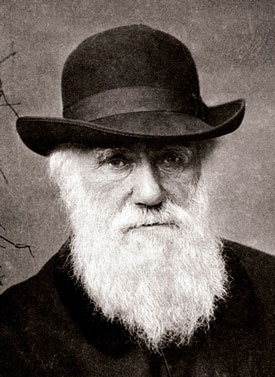
Famed naturalist, biologist Charles Darwin’s Theory of Evolution is at the center of controversy in the 29th century narrative of Kingsolver’s new book. (Photo: Wikimedia Commons By Elliott & Fry, Corbis Images, Public Domain)
KINGSOLVER: Well, that's a fascinating theoretical question, and I can't really imagine how I would answer it in any scientific way because there's no control group, there's no alternate universe where women were allowed to be scientists freely, but I think so much about Rachel Carson. She's a person I really admire. The first person in the United States to speak beyond scientific circles to everyday people. If you look at Silent Spring, it's an amazing document. It was a best selling work of nonfiction. It was very readable, very accessible and the years of its publication and if you look in that book, it has chemical formulas in it, it has drawings of carbon atoms and I think who would do this? This woman, this brilliant woman who had the moxie to say, yeah, I understand science and I think everybody else can understand this, too. I just have to take the time to respect the lay reader, to respect every day people, and, yeah, we need more Rachel Carsons.
CURWOOD: Or Mary Treats.
KINGSOLVER: Or Mary Treats.
CURWOOD: Or Barbara McClintocks. Or Barbara Kingsolvers.
KINGSOLVER: If you can't do it in science, do it in a novel. And I am lucky because I was trained as a scientist. I got my undergraduate and graduate degrees in biology, evolutionary biology and ecology. And then I became an novelist, and it's really fantastic to have all this material that I learned as a scientist that I can bring into the genre of fiction because I think it's very non-threatening. I think that a lot of people who might not think they were interested or might be intimidated to read a book, a scientific book, about some of these things I write about are less intimidated by a book that conveys this information through characters.
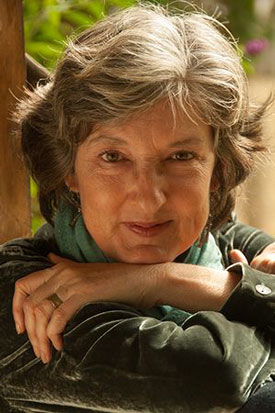
Barbara Kingsolver is the author of nine novels; her latest is Unsheltered. (Photo: Annie Griffiths and HarperCollins Publishers)
CURWOOD: So, how did your method in writing this novel change before and then after the 2016 election?
KINGSOLVER: You know, it didn't. And it's fascinating because I had begun writing, I plotted out the novel as the primaries started to happen, and so the characters are watching this very surprising almost unbelievable leadership style coming up on the horizon. It's hard to take seriously and yet he doesn't go away, and at some point, he even says something about I could shoot people on Fifth Avenue and I would still have loyal followers. OK, at the same time I'm writing my 19th century story, and so in Vineland when people are really afraid there's this guy named Charles Landis who's their, their founder who owns the newspaper and every business in town. He kind of owns everything, and he's kind of a big bully and he is real, he was a real historic personage, and I'm researching him and I discover he actually did shoot someone on Main Street and he got away with it. So, I thought it's just too good and too awful to be true. If this stuff really bears out I guess I'm launching this novel into a world that needs to read it.
CURWOOD: You frame Unsheltered as a way to talk about paradigm shifts. So, from all this research and your thinking, where are we headed now?
KINGSOLVER: When I look at any photograph of the leaders of my country, I see a bunch of guys in suits who formed their notion of what the world is in the 1950s and 60s, a period of US history when it really seemed like there was plenty of everything to go around. That post-war boom where you could just we could just grow forever and you can own everything. You could be the boss of everything, you really had it made, you were not going to ever have to sort of reign yourself in. I think it's actually very comforting to know that tomorrow's problems won't be solved by yesterday's people because they'll most mostly be dead. Tomorrow's problems are going to be solved by tomorrow's people, and I know a lot of young people who really inspire me who I think understand things about the world that I almost can't because they're coming up in a time when they've known since they were very small there will not always be more fish in the sea.
CURWOOD: Barbara Kingsolver's new book is called Unsheltered. Thanks so much for sharing this time with us.
KINGSOLVER: Thanks. It was great to talk with you.
Related links:
- Barbara Kingsolver’s Website
- Unsheltered Kirkus Review
- More on scientist Mary Treat
[MUSIC: Oliver the Crow, “45” on Olive the Crow, by Rachel Baiman, Ben Plotnick, and Kaitlyn Raitz]
Vegan Generation Gap
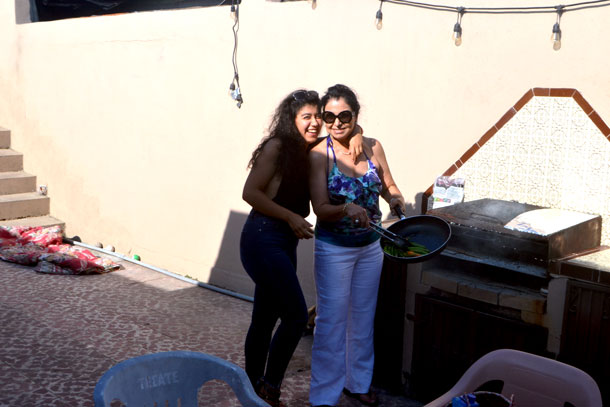
Paloma cooking with her mother, Marcia Fontes. (Photo: Courtesy of Paloma Beltran)
CURWOOD: More and more young people today are choosing to eat less meat as a way to take better care of the planet and themselves. But college student Paloma Beltran says it’s not always easy.
BELTRAN: My name is Paloma Beltran, I’m from Mexicali Baja California and I’m a student in Boston, Massachusetts.
One of my favorite things about visiting my family is my mom’s cooking.
My mom, to me, is an undiscovered celebrity masterchef. Her name is Marcia, and she is definitely the cook of the house. It’s amazing how everything she makes comes out tasting so good, like from a five star restaurant. I have always praised her culinary skills, I’m like her number one fan.
So when I went vegan it was a much harder job for her. I stopped eating a lot of her food because it contains dairy or animal products. She uses this seasoning called norswisa, which is made up of ground chicken – it basically contains the waddle, the beak, the legs… It’s a very common seasoning in Mexico.
So I was a little bit hesitant to continue eating her food, even though she claimed it was 100% vegan -- but I still did. Until one day – I caught her in the act. She was sprinkling some norswisa into a veggie broth. After that, I completely stopped eating her food, for months. And she was heartbroken.

Ratatouille is a dish that can be easily made using all vegan ingredients. (Photo: benmillett, Flickr CC BY-NC-ND 2.0)
It took her a while to try and incorporate vegan ingredients. I really didn’t expect her to, but she wanted to; which was very sweet of her. We started working together on vegan recipes -- things we could share. One of our favorite dishes is ratatouille. It’s very simple to make. It basically consists of eggplant, cebolla, tomates, tomato paste, vegan butter, ajo, and fresh parsley. You’d start off with a Pyrex and at the bottom you’d put vegan butter, onions, and salt and pepper. Then you’d soak slices of the berenjena in water, that way it softens up.
Once the eggplant is softened you can start making layers: of berenjena, tomato, onions, tomato paste, and seasoning. You’d continue making layers up to the top of the dish. Once you got to the top you’d sprinkle some fresh perejil, and then pop it into the oven, around 350 degrees. You’d leave it there until it’s softened up, and everything harmonizes. And that’s our favorite dish.
[MUSIC: Ten Years Gone (Jimmy Page and Robert Plant) Performed by The Hazelrigg Brothers on Songs we Like 2017 http://hazelriggbrothers.com/wp/]
CURWOOD: Next time on Living on Earth, the humanitarian crisis in the Gaza Strip as clean drinking water grows more scarce.
BROMBERG: It's a ticking time bomb. Should pandemic disease break out in Gaza people will start moving to the fences. And they won't be moving with stones or with rockets they'll be moving with empty buckets desperately calling out for clean water.
CURWOOD: The water crisis in Gaza next time on Living on Earth.
[MUSIC: Ten Years Gone (Jimmy Page and Robert Plant) Performed by The Hazelrigg Brothers on Songs we Like 2017 http://hazelriggbrothers.com/wp/]
CURWOOD: Living on Earth is produced by the World Media Foundation. Our crew includes Naomi Arenberg, Bobby Bascomb, Thurston Briscoe, Savannah Christiansen, Jenni Doering, Jaime Kaiser, Don Lyman, Lizz Malloy, Aynsley O’Neill, Jake Rego, Sarah Rappaport, Adelaide Chen, and Jolanda Omari.
Tom Tiger engineered our show. Alison Lirish Dean composed our themes. You can hear us anytime at L-O-E dot org, iTunes and Google play- and like us, please, on our Facebook page - PRI’s Living on Earth. And we tweet from @livingonearth. I’m Steve Curwood, Thanks for listening!
ANNOUNCER: Funding for Living on Earth comes from you our listeners and from the University of Massachusetts, Boston in association with its School for the Environment, developing the next generation of environmental leaders. And from the Grantham Foundation for the Protection of the Environment, supporting strategic communications and collaboration in solving the world’s most pressing environmental problems. Support also comes from the Energy Foundation, serving the public interest by helping to build a strong clean energy economy.
ANNOUNCER 2: PRI, Public Radio International.
Living on Earth wants to hear from you!
Living on Earth
62 Calef Highway, Suite 212
Lee, NH 03861
Telephone: 617-287-4121
E-mail: comments@loe.org
Newsletter [Click here]
Donate to Living on Earth!
Living on Earth is an independent media program and relies entirely on contributions from listeners and institutions supporting public service. Please donate now to preserve an independent environmental voice.
NewsletterLiving on Earth offers a weekly delivery of the show's rundown to your mailbox. Sign up for our newsletter today!
 Sailors For The Sea: Be the change you want to sea.
Sailors For The Sea: Be the change you want to sea.
 The Grantham Foundation for the Protection of the Environment: Committed to protecting and improving the health of the global environment.
The Grantham Foundation for the Protection of the Environment: Committed to protecting and improving the health of the global environment.
 Contribute to Living on Earth and receive, as our gift to you, an archival print of one of Mark Seth Lender's extraordinary wildlife photographs. Follow the link to see Mark's current collection of photographs.
Contribute to Living on Earth and receive, as our gift to you, an archival print of one of Mark Seth Lender's extraordinary wildlife photographs. Follow the link to see Mark's current collection of photographs.
 Buy a signed copy of Mark Seth Lender's book Smeagull the Seagull & support Living on Earth
Buy a signed copy of Mark Seth Lender's book Smeagull the Seagull & support Living on Earth

